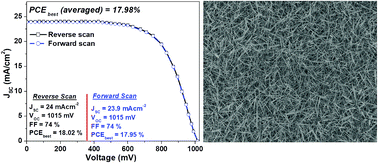MAPbI3 microneedle-arrays for perovskite photovoltaic application†
Abstract
Methyl-ammonium lead iodide perovskite (MAPbI3) was synthesized in the form of micro-needles via a hydrothermal route at a low temperature of 100 °C in a two-step procedure for the first time. The results exhibit that the amount of the surfactant is crucial for the synthesis of the MAPbI3 nanostructures with well-controlled morphologies. In contrast to bulk MAPbI3, the one-dimensional (1-D) micro-needle perovskite with a diameter of 200 nm showed an improved hole injection from the perovskite to the hole transporting layer (HTL), providing a unique platform at the perovskite/HTL interface. The best performing device employing MAPbI3 perovskite micro-needles yielded stable and hysteresis-free devices with a best power conversion efficiency of (PCEbest) of 17.98%. The current findings highlight the potential of perovskite micro-needles as novel absorber systems and lay the basis for future commercialization.

- This article is part of the themed collections: Nanoscale Advances Most Popular Articles so far and International Year of the Periodic Table : From Pb and Sn Perovskites to the Next Generation


 Please wait while we load your content...
Please wait while we load your content...